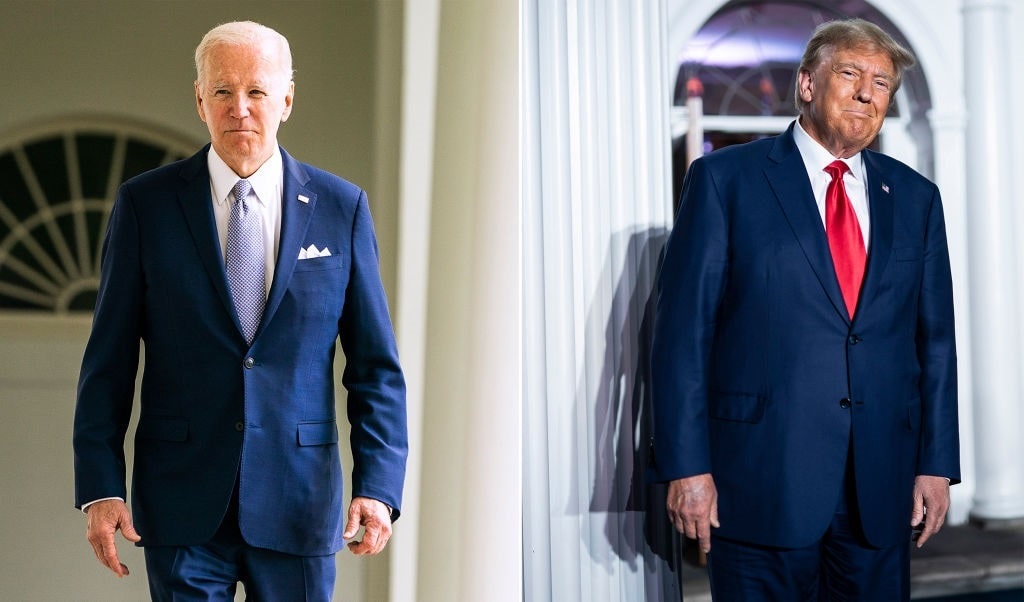One poll after another reveals that the prospective presidential race between Donald Trump and Joe Biden is a dead heat, or something close to it. While Trump finished ahead or tied in four of the five most recent surveys, Biden still holds the overall lead by a skinny 0.4%, according to Real Clear Politics. Trump hopes to convince voters of the utter ineptitude of Biden, who in turn will attempt to scare people out of Trump. But what about those voters who have not yet decided between the two? In a race where both candidates are viewed in many quarters as deeply flawed, and a solid majority of the public has made clear that they don’t want either man on the ballot, an argument on how undecided voters will break can be made either way in what is billed as a lesser-of-two-evils election.
In Trump and Biden, we have a matchup of two contenders for the presidency who are arguably better known by voters than any pair of candidates in history. Both have already served as president, carry distinct and opposite records, and are lapping the field in their respective primary contests to the point that they all but control their own fate. Thus, analysis of the race has centered around the likelihood that an overwhelming majority of voters have already made up their minds and that the sliver of undecided voters will be miniscule.
However, with the recent exhaustive poll of voter preferences and attitudes conducted by Republican and Democratic pollsters for The Wall Street Journal (WSJ) showing Trump and Biden tied at 46%, that leaves a full 8% of the electorate that claims to be undecided. While that may not sound like much, if turnout is similar to 2020, that would constitute some 12 million votes, more than enough to be decisive in the nail-biter everyone expects.
What Will Move Undecided Voters Off the Fence?
So, how will those pesky uncommitted voters decide between one candidate viewed by many or most impartial observers as too weak, and the other as too strong? Well, it is axiomatic that voters are driven primarily by self-interest, which largely revolves around the economy, widely considered Trump’s strength and Biden’s weakness. And sure enough, 58% of voters in the WSJ poll say the economy has gotten worse over the past two years, whereas only 28% say it has gotten better, and nearly three-in-four say inflation is headed in the wrong direction.
On top of that, 73% of voters, including two-thirds of Democrats, believe the 80-year-old Biden is too old to continue as president, compared to 47% who believe the same about the 77-year-old Trump, who finishes eight points ahead in mental competence. A majority – 51% – believe Trump had a record of accomplishment as president, while only 40% believe the same about Biden. And Biden is underwater – below 50% approval – on every major issue. Specifically, he’s below 40% on the economy, inflation, securing the border, and dealing with China.

Joe Biden and Donald Trump (Photo by Jabin Botsford/The Washington Post via Getty Images)
At the same time, though Trump actually finishes ahead in the category of “cares about people like you,” 48% of those polled said Biden is likable, compared to just 31% for Trump. And 45% viewed Biden as honest, while 38% said so of Trump.
This all leads to a fundamental bifurcation: “If this race is about personality and temperament, then Biden has an advantage. If this race is about policies and performance, then Trump has the advantage,” concludes WSJ’s GOP pollster, Frank Fabrizio.
Pundits have long argued over the enduring question of how undecided voters ultimately cast their ballots. A 2014 analysis of 25 senate races by a prominent Washington newspaper revealed that the average incumbent saw their share of the vote rise 2.5 points between the latest polls and Election Day, while the challengers’ final vote rose just 1.6 points. However, conventional wisdom among the consulting class is that undecided voters can generally be counted on to break for the challenger in the waning days of most campaigns. In what came to be known as the “incumbent rule,” an analysis of 155 races in the 1980s by the National Council on Public Polls concluded that “in races that include an incumbent … over 80% of the time, most or all of the undecideds voted for the challenger.”
Though he is anything but a conventional challenger, Donald Trump can only hope such history repeats itself in 2024.




